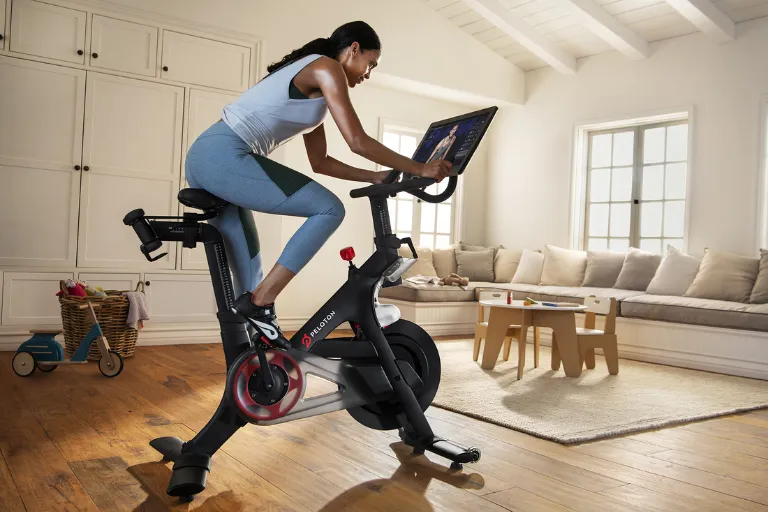Peloton and other home cycling platforms have made it possible to enjoy energetic spin classes without leaving home. With expert-led classes and interactive leaderboards, it’s easy to get hooked.
But without the right set-up and habits, even dedicated riders can develop sore knees, stiff backs, or wrist pain. As a physiotherapist, I see these issues often — and most are avoidable with a few small changes.
This guide will help you enjoy your indoor rides while protecting your joints, muscles, and long-term health.
Get Your Bike Fit Right
An incorrect bike fit is one of the most common causes of cycling discomfort. Even small errors can put extra strain on your knees, hips, and back over time.
Key adjustments to check:
- Saddle height: Place your heel on the pedal at its lowest point. Your knee should be almost straight. When clipped in, aim for about a 25–35° bend at the knee (1).
- Saddle fore–aft position: When the pedals are level, your forward knee should be directly above the pedal axle.
- Handlebar height: Beginners may find higher handlebars more comfortable for the neck and lower back.
Evidence: Low saddle height can increase knee joint forces and change the way your knee moves, which may lead to discomfort (1).
Warm Up Before You Push
Jumping into a heavy climb from cold is tough on your joints and muscles. A short warm-up helps your heart, lungs, and muscles prepare for harder work.
- Simple warm-up: Spend 5–7 minutes gradually increasing your pedalling speed and resistance. This allows joints to move more freely and muscles to activate effectively (2).
Evidence: Dynamic warm-ups improve muscle activation and flexibility compared with static stretching alone (2).
Balance Cadence and Resistance
Cadence is how fast you pedal; resistance is how hard it feels to push the pedals.
Too much resistance at a slow cadence can overload the knees.
Very high cadence with no resistance can make you lose control, straining hips or the lower back.
- Aim for: 80–100 revolutions per minute (RPM) for most rides. Go above 120 RPM only if you have excellent form and stability (3).
Evidence: Moderate cadences (80–100 RPM) can reduce peak joint forces compared with slower pedalling (3).
Train Smarter, Not Just Harder
Leaderboards and streaks can tempt riders to cycle every day. But your body needs rest to recover and adapt.
For a balanced routine:
- Take 1–2 rest or light recovery days each week.
- Add strength training for glutes, hamstrings, and core muscles.
- Include mobility exercises for the back, hips, and calves to prevent stiffness.
Evidence: Strength training supports cycling performance and helps protect against overuse injuries (4).
Listen to Early Warning Signs
Small niggles can turn into bigger problems if ignored.
- Pain at the front of the knee: Check saddle height and resistance.
- Lower back stiffness: Review posture and core engagement.
- Numbness in hands or wrists: Reduce grip pressure and adjust handlebar position.
If symptoms don’t improve after a few rides, seek advice from a qualified health professional. Early attention can prevent longer-term problems.
Try This Before Your Next Ride
Before your next Peloton session, take five minutes to check your saddle height, handlebar position, and warm-up routine. These small steps can make your rides more comfortable and help prevent common cycling aches.
Medical Disclaimer: This article has been written by a licensed health professional and is intended for general informational purposes only. It does not substitute for personalised medical advice, diagnosis, or treatment. Readers should always seek the guidance of a qualified healthcare provider with any questions regarding a medical condition or health objectives. Never ignore or delay seeking medical advice based on information presented here.
Subscribe for Free for more insightful health articles tailored to your needs.
References
1. Bini RR, Hume PA. Effects of saddle height on knee injury risk and cycling performance. Sports Medicine. 2014;44(6): 723–732. doi:10.1007/s40279-013-0143-5.
2. Ayala F, Sainz de Baranda P, De Ste Croix M, Santonja F. Acute and time-course effects of traditional and dynamic warm-up routines in young elite junior tennis players. Scandinavian Journal of Medicine & Science in Sports. 2012;22(4): 451–457. doi:10.1111/j.1600-0838.2010.01264.x.
3. Neptune RR, Hull ML. A theoretical analysis of preferred pedalling rate selection in endurance cycling. Journal of Biomechanics. 1999;32(4): 409–415. doi:10.1016/S0021-9290(98)00181-1.
4. Rønnestad BR, Mujika I. Optimising strength training for running and cycling endurance performance: A review. Scandinavian Journal of Medicine & Science in Sports. 2014;24(4): 603–612. doi:10.1111/sms.12104.




